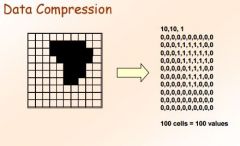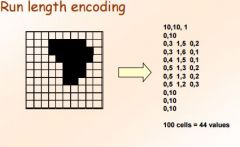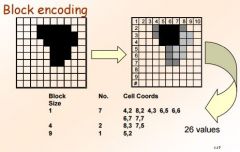![]()
![]()
![]()
Use LEFT and RIGHT arrow keys to navigate between flashcards;
Use UP and DOWN arrow keys to flip the card;
H to show hint;
A reads text to speech;
24 Cards in this Set
- Front
- Back
|
The Major Models - Raster |
regular grid |
|
|
rows from top left |
each cell with one value |
|
|
fills whole area |
one set = layer |
|
|
Raster Representation of Discrete SpatialEntities |
Points arerepresented assingle grid cells |
|
|
Lines representedas a series ofconnected grid cells |
Areas representedby series ofconnected grid cells |
|
|
Raster shows whatoccurs everywhere |
– Vector showswhere everythingoccurs |
|
|
Raster - Key Issues |
Resolution -Quantitative -Qualitative |
|
|
Data compression |
Suitability to application |
|
|
Requirements for scanning |
-documents must be clean (no smudges or extramarkings) -complex line work provides greater chance oferror in scanning -text may be accidently scanned as line features |
|

|

|
|

|

|
|
|
Cell values: whole numbers (integers) -32767 to +32767 |
Cell values: decimal (real) values (+/- 1 x 1038 withprecision of 7 significant figures) |
|
|
Cell values: byte values ranging from 0 to 255 |
Cell values: Integers as codes 0 = "no class” 1 = "fine sandy loam" 2 = "coarse sand" 3 = "gravel" |
|
|
Map layers: each cell - one value • Generalisation |
Map layers:each theme/item type - one layer – soils – vegetation – roads – water – urban area |
|
|
Map layers: each theme/item type - one layer • hundreds of layers used |
Map layers: each theme/item type - one layer • each layer hundreds or thousands of cells |
|
|
Map layers: Qualitative • Classification detail • grid size/density |
Map layers: Quantitative • smallest unit(cell/pixel)used • smaller (higherresolution/morepixels/moredetail/more computermemory and speedneeded) |
|
|
Raster: Disadvantages • Data redundancy |
Raster: Disadvantages • All grids either square orrectangular |
|
|
Raster: Disadvantages • Must store value for allcells |
Raster: Disadvantages • No “empty space” even ifyou want it! |
|
|
Raster: Disadvantages • Can be less aestheticallypleasing |
Raster: Disadvantages • Exact shapes of entitiesare only approximated |
|
|
Raster: Disadvantages • Accuracy ofmeasurements limited byresolution |
Raster: Disadvantages • The “mixel” problem |
|
|
Raster: Disadvantages • Weak with nominal data |
Raster: Advantages •Simple structure |
|
|
Raster: Advantages Superior representation ofcontinuous phenomena |
Raster: Advantages Ideally suited forquantitative combinationsof multiple data layers |
|
|
Raster: Advantages Makes it very easy to writecomputer models assequences of computations |
Raster: Advantages In general, much broaderrange of analysiscapabilities |
|
|
Raster: Advantages Compatibility with digitalsatellite imagery/aerialphotography |
Raster: Advantages Good for viewshed and costsurface analysis |

